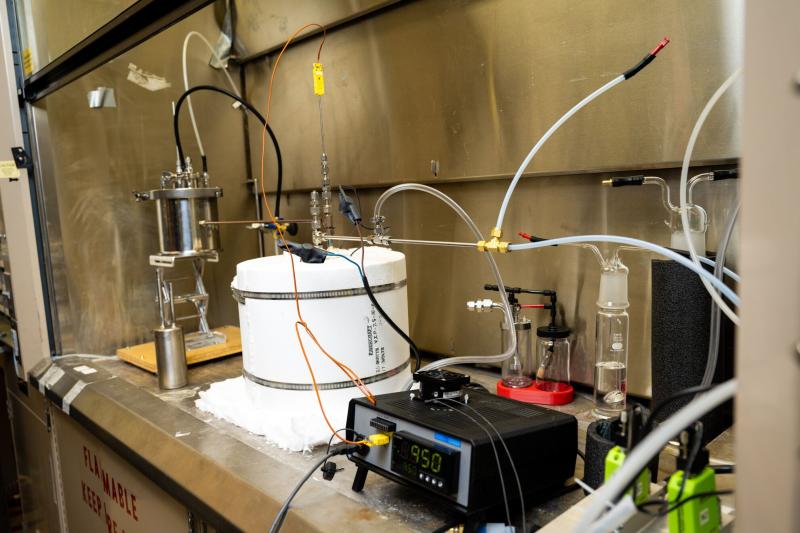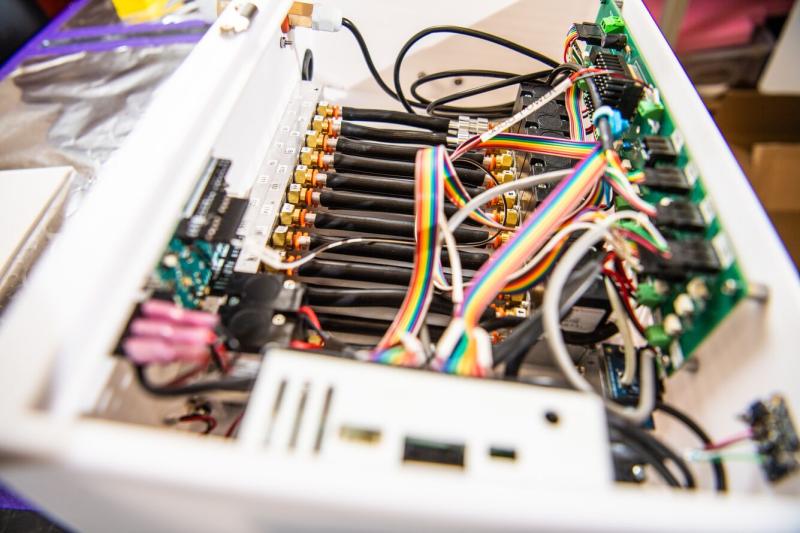Environmental Transformations and Interactions
Aerosols: Tiny Particles with a Big Role in Climate Processes
EMSL scientists use a unique combination of expertise and premier capabilities to target key questions about aerosols and climate

Scientists at the Environmental Molecular Sciences Laboratory are using a specialized blend of in-house expertise and capabilities to explore important questions about aerosols and their role in our climate.
(Photo by Andrea Starr | Pacific Northwest National Laboratory)
Just about every time you look to the sky, you’ll see clouds. Clouds are essential for regulating the planet’s temperature and transporting water all over the globe, making them a key steward of life on Earth. While massive, clouds typically begin their lives as tiny droplets that nucleate around airborne particles known as aerosols. Aerosols can come from a variety of sources—natural origins such as sea spray and volcanoes, as well as artificial ones like burning fossil fuels.
Despite their fundamental importance to clouds, there are still key knowledge gaps about the precise relationship between aerosols and climate. In the face of a warming world, this becomes an especially crucial area of research.
A group of scientists at the Environmental Molecular Sciences Laboratory (EMSL), a Department of Energy user facility, is tackling this challenge with a leading combination of emerging research, premier analytical capabilities, and on-site expertise.
“The truly unique thing we can offer at EMSL is the accessibility of all of these capabilities in one location—users can combine the tools and techniques we offer with our on-site expertise to get a more holistic understanding of aerosols and climate,” says Gregory Vandergrift, a postdoctoral researcher at EMSL.
Vandergrift and his colleagues, EMSL postdoctoral scientists Nurun Nahar Lata and Zezhen (Jay) Cheng, work closely with chemist Swarup China, who leads EMSL’s Terrestrial–Atmospheric Processes Integrated Research Platform.
Vandergrift, Lata, and Cheng will talk in depth about how potential users can access EMSL’s aerosol research capabilities during an EMSL LEARN series webinar on April 26 from noon to 1 p.m. Pacific daylight time.
Controlled combustion system
Spearheaded by Cheng, the controlled combustion system is a unique capability available to EMSL users. This tool is a lab-controlled system that precisely generates aerosols, which can then be analyzed using different analytical platforms available at EMSL, particularly high-resolution mass spectrometry and microscopy instruments. The chamber enables researchers to tailor the specific conditions around the aerosols they produce, allowing them to simulate various combustion conditions and therefore to better understand how aerosols form and how they affect our climate.

During Cheng’s postdoctoral work, he created what would become the precursor to the controlled combustion system he later established at EMSL. While combustion chambers exist in various forms for this kind of research, the one at EMSL stands apart. “This is a customized, user-available tool developed at EMSL,” says Cheng. Vandergrift adds, “that combined with the expertise we offer is what makes this chamber a really unique capability.”
Size and time-resolved aerosol collector (STAC)
While it is relatively easy to collect aerosol samples at the ground level, taking samples from the atmosphere is more challenging. The size and time-resolved aerosol collector (STAC) platform is specifically designed to address this problem. STAC is multifunctional—it can be deployed both to access ground-level samples and to obtain samples from the atmosphere using unmanned systems such as the Department of Energy, Atmospheric Radiation Measurement (ARM) user facility’s tethered balloon system. The STAC also monitors the environmental conditions surrounding the sample at the time it was taken, providing important information about the context in which aerosols evolve.
“This dual capability that STAC has allows us to directly compare ground and atmospheric samples and to investigate how each affects climate,” says Lata, who will discuss STAC in more detail during the upcoming webinar.

(Photo by Andrea Starr | Pacific Northwest National Laboratory)
“The STAC is in many ways a sample collection platform,” adds Cheng. “Different sensors monitor things like temperature, pressure, and particle concentration, providing us with crucial data about meteorological conditions immediately surrounding the sample.”
Once the STAC retrieves a sample, it’s brought back to the lab for analysis. Which analytical technique researchers plan to use dictates exactly how the STAC collects the sample—different instruments require different sample inputs.
“Samples collected by the STAC hold a wealth of information that can be unlocked with the analytical techniques available at EMSL,” Lata says. “Properties like particle composition, carbon content, and size are vital for understanding how aerosols affect the climate.”
EMSL instrument suite
Once techniques such as the controlled combustion chamber and STAC generate and collect aerosol samples, those samples can be analyzed using one of the many specialized instruments available at EMSL. There are two broad instrument categories for studying aerosols at EMSL—microscopy and mass spectrometry.
Microscopy
EMSL’s microscopy capabilities include scanning electron microscopes (SEMs). The ice nucleation environmental SEM (IN-ESEM) is especially useful for the kinds of studies Lata, Cheng, and Vandergrift pursue because aerosols play a central role in ice nucleation processes. Like their aerosol precursors, ice particles themselves are known to be vital players in cloud dynamics such as lightning and precipitation.
Other microscopy techniques available at EMSL include computer controlled SEM (CCSEM) and transmission electron microscopy (TEM). CCSEM is computer controlled to allow for automated analyses and is coupled with another analytical technique called energy dispersive X-ray spectroscopy. Together, this duo can provide researchers with the elemental composition of each particle in a sample, often numbering in the thousands—ideal for aerosol research.
TEM is also a powerful tool for aerosol studies because it can analyze the structure of incredibly small specimens. At EMSL, the environmental TEM capability can help track how aerosols evolve under a variety of conditions, making it perfect for atmospheric research.
Mass spectrometry
Mass spectrometry (MS) is another instrument class important for aerosol studies. MS can be used to identify the different molecules that make up an aerosol sample—similar to how specific groups of puzzle pieces form a unique puzzle.
Nano-DESI, or nanospray desorption electrospray ionization mass spectrometry, is an important link in the aerosol analysis pathway. This MS technique is highly sensitive, making it especially useful for very dilute samples—a common issue in atmospheric research. Nano-DESI can provide a molecular-level understanding of complex particle mixtures.
To access these and other EMSL resources, potential users can submit research proposals to one of EMSL’s open calls.
To learn more about EMSL’s aerosol research capabilities, register for the EMSL LEARN webinar on April 26, noon to 1 p.m. PDT.

